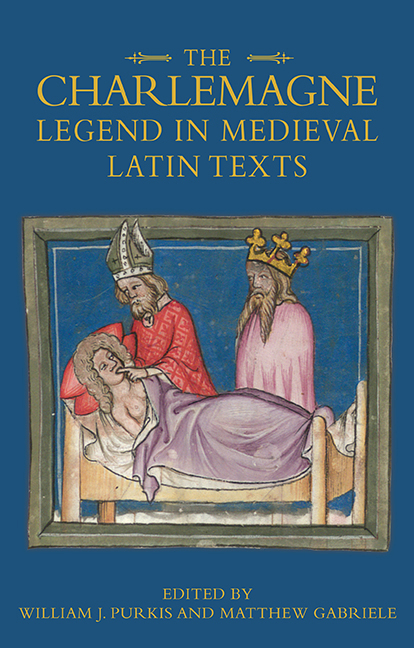Book contents
- Frontmatter
- Dedication
- Contents
- List of Illustrations
- Contributors
- General preface Charlemagne: A European Icon
- Acknowledgements
- List of Abbreviations
- Introduction The Many Latin Lives of Charlemagne
- 1. Frankish Kingship, Political Exegesis and the Ghost of Charlemagne in the Diplomas of King Philip I of Francia
- 2. The Twelfth-Century Vita Karoli and the Making of a Royal Saint
- 3. Performing Sacrality: The Liturgical Portrait of Frederick Barbarossa's Charlemagne
- 4. Rex Parvus or Rex Nobilis? Charlemagne and the Politics of History (and Crusading) in Thirteenth-Century Iberia
- 5. Charlemagne in Girona: Liturgy, Legend and the Memory of Siege
- 6. ‘For the Honour of the Blessed Virgin’: The History and Legacy of Charles's Devotion to Mary in the Gesta Karoli Magni ad Carcassonam et Narbonam
- 7. Charlemagne the Sinner: Charles the Great as Avatar of the Modern in Petrarch's Familiares 1.4
- 8. The Quattrocento Charlemagne: Franco–Florentine Relations and the Politics of an Icon
- Index
- Miscellaneous Endmatter
Introduction The Many Latin Lives of Charlemagne
Published online by Cambridge University Press: 25 October 2017
- Frontmatter
- Dedication
- Contents
- List of Illustrations
- Contributors
- General preface Charlemagne: A European Icon
- Acknowledgements
- List of Abbreviations
- Introduction The Many Latin Lives of Charlemagne
- 1. Frankish Kingship, Political Exegesis and the Ghost of Charlemagne in the Diplomas of King Philip I of Francia
- 2. The Twelfth-Century Vita Karoli and the Making of a Royal Saint
- 3. Performing Sacrality: The Liturgical Portrait of Frederick Barbarossa's Charlemagne
- 4. Rex Parvus or Rex Nobilis? Charlemagne and the Politics of History (and Crusading) in Thirteenth-Century Iberia
- 5. Charlemagne in Girona: Liturgy, Legend and the Memory of Siege
- 6. ‘For the Honour of the Blessed Virgin’: The History and Legacy of Charles's Devotion to Mary in the Gesta Karoli Magni ad Carcassonam et Narbonam
- 7. Charlemagne the Sinner: Charles the Great as Avatar of the Modern in Petrarch's Familiares 1.4
- 8. The Quattrocento Charlemagne: Franco–Florentine Relations and the Politics of an Icon
- Index
- Miscellaneous Endmatter
Summary
AS all medievalists know, 2014 marked the anniversary of a significant moment in European history: the twelve-hundredth year since the death of Charles, later Karolus Magnus, Charles the Great – Charlemagne. From that moment, the life of Charles as an historical actor – a king, an emperor – began to give way and transform into something else: the Charles of history became the Charlemagne of legend. The so-called ‘raw materials’ for this transformation included Einhard's Latin life of Charlemagne, the Vita Karoli Magni, which was probably composed in the late 820s and which portrayed the emperor as ‘an ideal ruler who ruled over an ideal age’. From that starting point, through Notker the Stammerer's Gesta Karoli Magni (885–7), the Historia Turpini (c. 1140), and many other texts, the Charlemagne legend gathered momentum and was elaborated, so that by the close of the twelfth century Charles was being celebrated as, among other things, a founder of monasteries, a donor of relics, a Jerusalem pilgrim, a protocrusader, and, indeed, a saint.
All studies of the process by which Charlemagne passed from history into legend are indebted to the foundational work of Robert Folz, especially his Le souvenir et la legende de Charlemagne dans l'Empire germanique medieval, but recent years in particular have seen a renewed enthusiasm for the subject – a historiographical development that Thomas Noble has memorably dubbed ‘Charlemania’. The publication of a collection of essays titled The Legend of Charlemagne: Power, Faith, and Crusade in 2008, for example, demonstrated the value and potential of a broader interdisciplinary approach to the subject, incorporating work by historians, art historians and literary specialists on source materials originating from the ninth to the thirteenth centuries; the volume's significance for the field is evident from the frequency with which it is cited in the chapters below. In 2011 one of the editors of that volume (and the co-editor of this one), Matthew Gabriele, went on to add significantly to our knowledge and understanding of the legend's early history through a wide-ranging examination of Carolingian memory during the period 814–c. 1100.
- Type
- Chapter
- Information
- The Charlemagne Legend in Medieval Latin Texts , pp. 1 - 8Publisher: Boydell & BrewerPrint publication year: 2016



